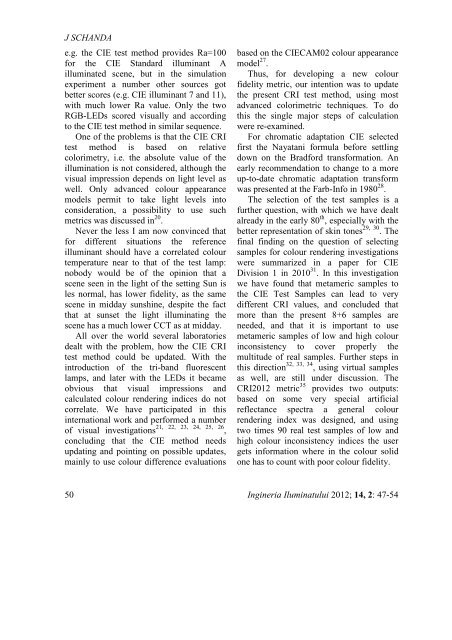Untitled - Journal of Lighting Engineering
Untitled - Journal of Lighting Engineering
Untitled - Journal of Lighting Engineering
Create successful ePaper yourself
Turn your PDF publications into a flip-book with our unique Google optimized e-Paper software.
J SCHANDA<br />
e.g. the CIE test method provides Ra=100<br />
for the CIE Standard illuminant A<br />
illuminated scene, but in the simulation<br />
experiment a number other sources got<br />
better scores (e.g. CIE illuminant 7 and 11),<br />
with much lower Ra value. Only the two<br />
RGB-LEDs scored visually and according<br />
to the CIE test method in similar sequence.<br />
One <strong>of</strong> the problems is that the CIE CRI<br />
test method is based on relative<br />
colorimetry, i.e. the absolute value <strong>of</strong> the<br />
illumination is not considered, although the<br />
visual impression depends on light level as<br />
well. Only advanced colour appearance<br />
models permit to take light levels into<br />
consideration, a possibility to use such<br />
metrics was discussed in 20 .<br />
Never the less I am now convinced that<br />
for different situations the reference<br />
illuminant should have a correlated colour<br />
temperature near to that <strong>of</strong> the test lamp:<br />
nobody would be <strong>of</strong> the opinion that a<br />
scene seen in the light <strong>of</strong> the setting Sun is<br />
les normal, has lower fidelity, as the same<br />
scene in midday sunshine, despite the fact<br />
that at sunset the light illuminating the<br />
scene has a much lower CCT as at midday.<br />
All over the world several laboratories<br />
dealt with the problem, how the CIE CRI<br />
test method could be updated. With the<br />
introduction <strong>of</strong> the tri-band fluorescent<br />
lamps, and later with the LEDs it became<br />
obvious that visual impressions and<br />
calculated colour rendering indices do not<br />
correlate. We have participated in this<br />
international work and performed a number<br />
<strong>of</strong> visual investigations 21, 22, 23, 24, 25, 26 ,<br />
concluding that the CIE method needs<br />
updating and pointing on possible updates,<br />
mainly to use colour difference evaluations<br />
based on the CIECAM02 colour appearance<br />
model 27 .<br />
Thus, for developing a new colour<br />
fidelity metric, our intention was to update<br />
the present CRI test method, using most<br />
advanced colorimetric techniques. To do<br />
this the single major steps <strong>of</strong> calculation<br />
were re-examined.<br />
For chromatic adaptation CIE selected<br />
first the Nayatani formula before settling<br />
down on the Bradford transformation. An<br />
early recommendation to change to a more<br />
up-to-date chromatic adaptation transform<br />
was presented at the Farb-Info in 1980 28 .<br />
The selection <strong>of</strong> the test samples is a<br />
further question, with which we have dealt<br />
already in the early 80 th , especially with the<br />
better representation <strong>of</strong> skin tones 29, 30 . The<br />
final finding on the question <strong>of</strong> selecting<br />
samples for colour rendering investigations<br />
were summarized in a paper for CIE<br />
Division 1 in 2010 31 . In this investigation<br />
we have found that metameric samples to<br />
the CIE Test Samples can lead to very<br />
different CRI values, and concluded that<br />
more than the present 8+6 samples are<br />
needed, and that it is important to use<br />
metameric samples <strong>of</strong> low and high colour<br />
inconsistency to cover properly the<br />
multitude <strong>of</strong> real samples. Further steps in<br />
this direction 32, 33, 34 , using virtual samples<br />
as well, are still under discussion. The<br />
CRI2012 metric 35 provides two outputs:<br />
based on some very special artificial<br />
reflectance spectra a general colour<br />
rendering index was designed, and using<br />
two times 90 real test samples <strong>of</strong> low and<br />
high colour inconsistency indices the user<br />
gets information where in the colour solid<br />
one has to count with poor colour fidelity.<br />
50 Ingineria Iluminatului 2012; 14, 2: 47-54
















